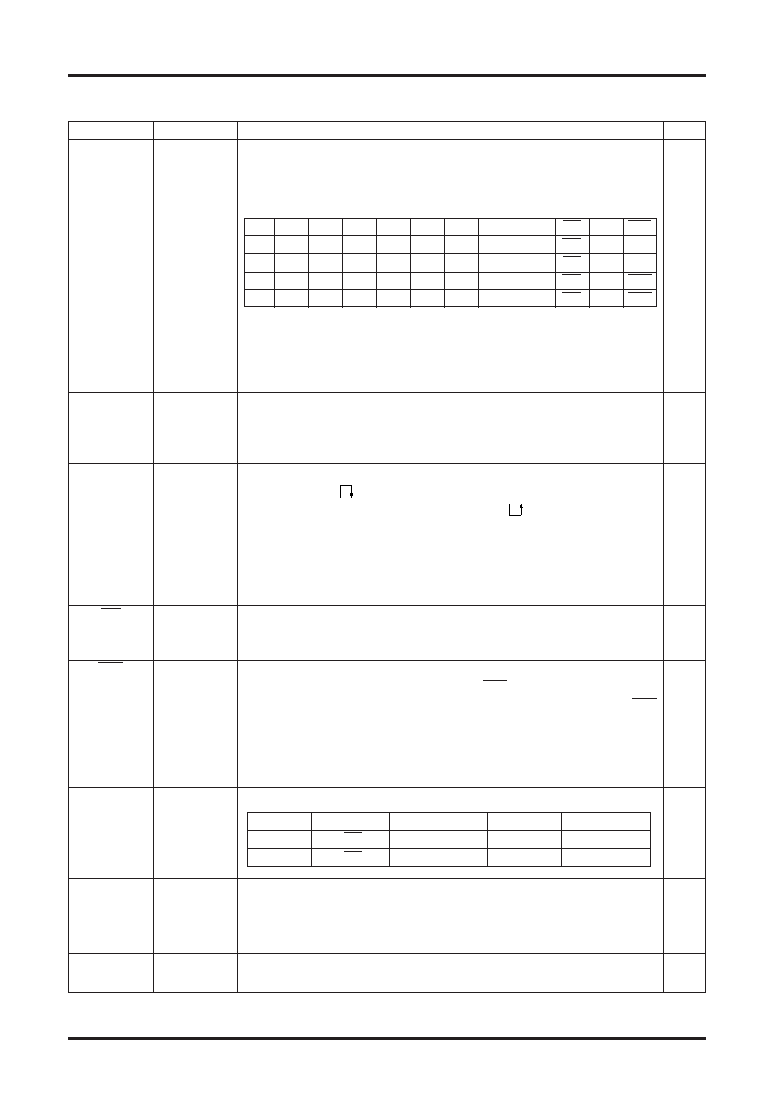- 您現(xiàn)在的位置:買(mǎi)賣IC網(wǎng) > PDF目錄98079 > SED122ADXA 16 X 60 DOTS DOT MAT LCD DRVR AND DSPL CTLR, UUC165 PDF資料下載
參數(shù)資料
| 型號(hào): | SED122ADXA |
| 元件分類: | 顯示控制器 |
| 英文描述: | 16 X 60 DOTS DOT MAT LCD DRVR AND DSPL CTLR, UUC165 |
| 封裝: | DIE-165 |
| 文件頁(yè)數(shù): | 4/50頁(yè) |
| 文件大小: | 398K |
| 代理商: | SED122ADXA |
第1頁(yè)第2頁(yè)第3頁(yè)當(dāng)前第4頁(yè)第5頁(yè)第6頁(yè)第7頁(yè)第8頁(yè)第9頁(yè)第10頁(yè)第11頁(yè)第12頁(yè)第13頁(yè)第14頁(yè)第15頁(yè)第16頁(yè)第17頁(yè)第18頁(yè)第19頁(yè)第20頁(yè)第21頁(yè)第22頁(yè)第23頁(yè)第24頁(yè)第25頁(yè)第26頁(yè)第27頁(yè)第28頁(yè)第29頁(yè)第30頁(yè)第31頁(yè)第32頁(yè)第33頁(yè)第34頁(yè)第35頁(yè)第36頁(yè)第37頁(yè)第38頁(yè)第39頁(yè)第40頁(yè)第41頁(yè)第42頁(yè)第43頁(yè)第44頁(yè)第45頁(yè)第46頁(yè)第47頁(yè)第48頁(yè)第49頁(yè)第50頁(yè)

4–12
EPSON
SED1220
Pin name
I/O
Description
Q’ty
D7 (SI)
I
8-bit input data bus. These pins are connected to a 8-bit or 16-bit
8
D6 (SCL)
standard MPU data bus.
D5 ~ D0
When P/S = “Low”, the D7 and D6 pins are operated as a serial data
input and a serial clock input respectively.
A0
I
Usually, this pin connects the least significant bit of the MPU address
1
bus and identifies a data command.
0 : Indicates that D0 to D7 are a command.
1 : Indicates that D0 to D7 are display data.
RES
I
In case of a 68 series MPU, initialization can be performed by
1
changing RES
. In case of an 80 series MPU,
initialization can be performed by changing
.
A reset operation is performed by edge sensing of the RES signal.
An interface type for the 68/80 series MPU is selected by input level
after initialization.
“L”
: 68 series MPU interface
“H” : 80 series MPU interface
CS
I
Chip select signal. Usually, this pin inputs the signal obtained by
1
decoding an address bus signal. At the “Low” level, this pin is
enabled.
WR
I
<When connecting an 80 series MPU>
Active “Low”. This pin connects the WR signal of the 80 series
1
(E)
MPU. The signal on the data bus is fetched at the rise of the WR
signal.
<When connecting a 68 series MPU>
Active “High”. This pin becomes an enable clock input of the 68
series MPU.
P/S
I
This pin switches between serial data input and parallel data input.
1
IF
I
Interface data length select pin for parallel data input.
1
“High”: 8-bit parallel input
“Low”: 4-bit parallel input
When P/S = “Low”, connect this pin to VDD or VSS.
CK
I
External input terminal
It must be fixed to “High” when the internal oscillation circuit is used.
1
Pins for System Bus Connection
P/S RES I/F
D7
D6
D5
D4
D3-D0
CS
A0
WR
“L”
—
SI
SCL
—
OPEN
CS
A0
—
“H”
D7
D6
D5
D4
D3-D0
CS
A0
E
“H”
“L”
“H”
D7
D6
D5
D4
D3-D0
CS
A0
WR
“H”
“L”
D7
D6
D5
D4
OPEN
CS
A0
WR
P/S
Chip Select Data/Command
Data
Serial Clock
“High”
CS
A0
D0~D7
–
“Low”
CS
A0
SI
SCL
RES: Indicates the active potential.
OPEN:Though “OPEN” is available, fixing the potential is
recommended for noise-withstnading characteristical reason.
—:
Indicates that it can be set at either “H” or “L”, but fixing the
potential is required.
相關(guān)PDF資料 |
PDF描述 |
|---|---|
| SED1278FOD | 16 X 40 DOTS DOT MAT LCD DRVR AND DSPL CTLR, PQFP80 |
| SED1278F | 16 X 40 DOTS DOT MAT LCD DSPL CTLR, PQFP80 |
| SED1330FBA | DOT MAT LCD DSPL CTLR, PQFP60 |
| SED1330FBB | 640 X 256 DOTS DOT MAT LCD DSPL CTLR, PQFP60 |
| SED1335FOA | DOT MAT LCD DSPL CTLR, PQFP60 |
相關(guān)代理商/技術(shù)參數(shù) |
參數(shù)描述 |
|---|---|
| SED1278 | 制造商:未知廠家 制造商全稱:未知廠家 功能描述:CMOS DOT MATRIX LCD CONTROLLER DRIVER |
| SED1278D | 制造商:EPSON 制造商全稱:EPSON 功能描述:Dot Matrix LCD Controller Driver |
| SED1278D0A | 制造商:未知廠家 制造商全稱:未知廠家 功能描述:CMOS DOT MATRIX LCD CONTROLLER DRIVER |
| SED1278D0B | 制造商:未知廠家 制造商全稱:未知廠家 功能描述:CMOS DOT MATRIX LCD CONTROLLER DRIVER |
| SED1278D0C | 制造商:未知廠家 制造商全稱:未知廠家 功能描述:CMOS DOT MATRIX LCD CONTROLLER DRIVER |
發(fā)布緊急采購(gòu),3分鐘左右您將得到回復(fù)。